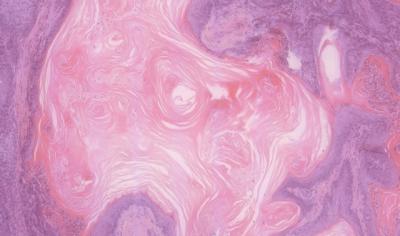CNIO researchers discover 1 of the genetic pieces of bladder cancer

This image shows a squamous-cell bladder carcinoma from Notch-deficient mice. Credit: ASCI
Now, CNIO researchers clear this dilemma up for bladder cancer, in which it exerts an anti-tumour effect. This result calls for caution when using therapeutic strategies based on the deactivation of Notch, because they could increase the risk of developing bladder cancer.
The study, published by The Journal of Clinical Investigation, is a joint effort between CNIO's Tumour Suppression and Epithelial Carcinogenesis Groups, led by Manuel Serrano and Francisco X. Real, respectively. In addition to clarifying the role that Notch plays in bladder cancer–the fifth most frequent cancer among men in developed countries–the authors offer clues to understand the dual function of this family of genes.
“Our analysis of Notch mutations in bladder cancer, mouse models, cell-based assays and human cancer samples offer solid evidence that the Notch pathway plays a relevant role as a tumour suppressor in bladder cancer,” they write.
This result is not a surprise. Many of the tumours in which Notch acts as a suppressor are cancers that arise in squamous cells, which are found in different organs, such as the oesophagus or the skin. The urinary bladder can give rise to squamous cell cancer, so “we hypothesized that Notch could act as a suppressor in this tissue,” explains the article.
The confirmation of this hypothesis supports the idea that Notch intervenes in the architecture of the so-called stratified epithelia, in which cells grow in superimposed layers –a type of growth that also takes place in the bladder.
The researchers from the two CNIO groups brought together their strength and expertise. The Epithelial Carcinogenesis Group had sequenced the exome–the part of the genome that is translated into proteins–for 17 bladder cancers, and detected Notch mutations. The Tumour Suppression Group provided mouse models for the genetic inactivation of Notch, specifically in the bladder.
The study concludes with a call for caution: “Our group as well as other investigators had previously described the anti-tumour effects of pharmacologic inhibitors of Notch in pre-clinical models [of lung adenocarcinoma, where Notch is oncogenic]; our current data suggest that caution must be taken in the clinical application of non-specific Notch pathway inhibition, because it could increase the incidence of squamous-type tumours, like in the bladder.”
###
The work has been funded by the Ministry of Economy and Competitiveness, the European Union and the European Research Council (ERC), the Community of Madrid, the Botin Foundation, the Ramon Areces Foundation, the AXA Foundation and the Spanish Association Against Cancer.
Reference article:
NOTCH pathway inactivation promotes bladder cancer progression. Antonio Maraver, Pablo J. Fernandez-Marcos, Timothy P. Cash, Marinela Mendez-Pertuz, Marta Duenas, Paolo Maietta,Paola Martinelli, Maribel Munoz-Martin, Monica Martinez-Fernandez,Marta Canamero, Giovanna Roncador, Jorge L. Martinez-Torrecuadrada, Dimitrios Grivas, Jose Luis de la Pompa, Alfonso Valencia, Jesus M. Paramio, Francisco X. Real, Manuel Serrano. The Journal of Clinical Investigation (2015). doi: 10.1172/JCI78185.
Media Contact
All latest news from the category: Life Sciences and Chemistry
Articles and reports from the Life Sciences and chemistry area deal with applied and basic research into modern biology, chemistry and human medicine.
Valuable information can be found on a range of life sciences fields including bacteriology, biochemistry, bionics, bioinformatics, biophysics, biotechnology, genetics, geobotany, human biology, marine biology, microbiology, molecular biology, cellular biology, zoology, bioinorganic chemistry, microchemistry and environmental chemistry.
Newest articles

Recovering phosphorus from sewage sludge ash
Chemical and heat treatment of sewage sludge can recover phosphorus in a process that could help address the problem of diminishing supplies of phosphorus ores. Valuable supplies of phosphorus could…

Efficient, sustainable and cost-effective hybrid energy storage system for modern power grids
EU project HyFlow: Over three years of research, the consortium of the EU project HyFlow has successfully developed a highly efficient, sustainable, and cost-effective hybrid energy storage system (HESS) that…

After 25 years, researchers uncover genetic cause of rare neurological disease
Some families call it a trial of faith. Others just call it a curse. The progressive neurological disease known as spinocerebellar ataxia 4 (SCA4) is a rare condition, but its…





















